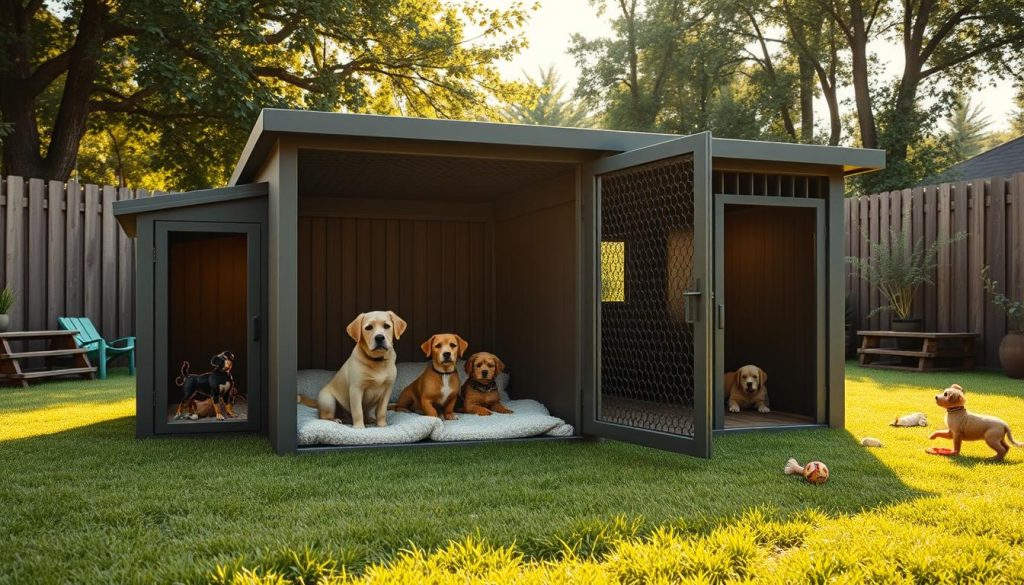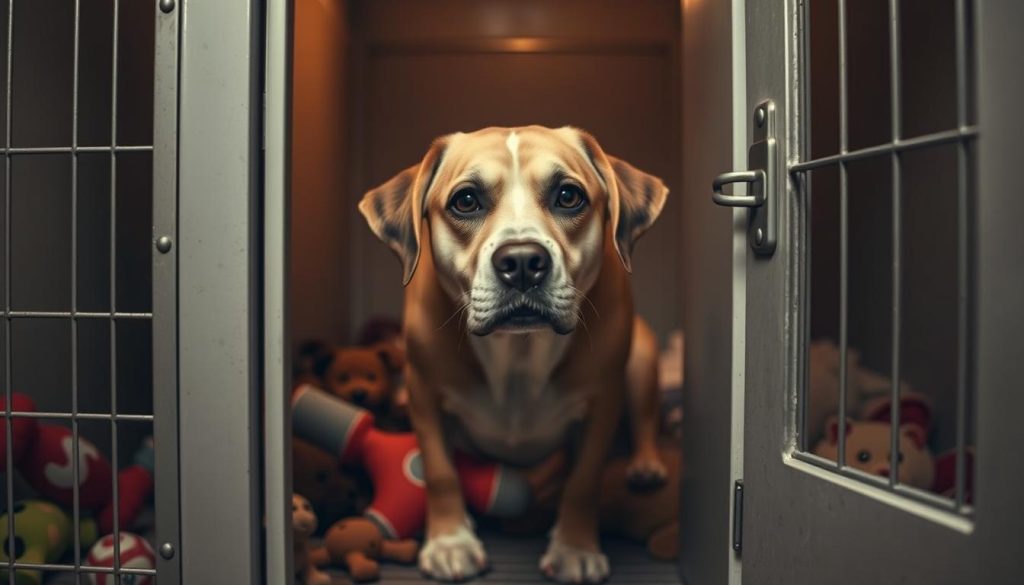As a dog owner, I know how crucial kennel training is for my pet’s happiness and my own calm. In this article, I’ll share how I crate-trained my pup. It helped them feel safe and happy in their own space.
Teaching your dog to love their dog kennel is a big win for both of you. It gives them a cozy, secure spot. It also makes caring for your pet much simpler.
Whether you’re new to dog ownership or want to improve your kennel training techniques, this guide has you covered. It’s all about making crate training a breeze for you and your puppy.
Understanding the Importance of Kennel Training
Kennel training is key for dog owners. It gives your dog a safe place to rest and relax. It also helps them feel secure and comfortable.
Kennel training has many benefits. It improves your dog’s well-being and your relationship with them.
Why Kennel Training is Crucial for Your Furry Friend
Kennel training makes dogs feel safe and happy in their own space. It’s great for puppies or rescue dogs adjusting to a new home. The kennel is a cozy spot for them to go when they feel overwhelmed.
This helps prevent bad behaviors and anxiety when left alone.
Benefits of Proper Kennel Training
Spending time on kennel training brings big rewards. Here are some key benefits:
- Housebreaking is easier: Dogs avoid soiling their sleeping area, making housetraining simpler.
- Safer transportation: A trained dog is calmer and safer in cars and at vet visits.
- Less anxiety and bad behaviors: A dog that likes their kennel is less likely to chew or scratch when alone.
The value of kennel training is huge. It helps your dog feel secure and happy. This makes them well-adjusted and confident.
Preparing for Kennel Training

Starting kennel training with your dog is exciting. It’s important to pick the right kennel size and type for success. You want a balance between enough space for movement and a cozy, secure spot.
Choosing the Right Kennel Size
Choosing the right kennel size is key. It should let your dog stand up, turn around, and lie down comfortably. Measure your dog’s height, length, and width to find the perfect kennel size.
The kennel should be big enough but not too big. It should not be so large that your dog uses one end for the bathroom and the other for sleeping.
Exploring Different Kennel Types
After finding the right size, think about the kennel type. You can choose from metal wire crates, plastic kennels, or even soft-sided ones. Each has its own benefits, so pick the one that fits your dog’s personality and your home.
Choosing the right kennel size and type is crucial for a successful training. With the right setup, your dog will feel safe and ready for this important step in their development.
Dog Kennel Training: A Step-by-Step Guide

Starting kennel training for your dog might seem tough. But, with a gentle and encouraging method, your dog will learn to love their kennel. Here’s a simple guide to help your dog feel at home in their kennel.
Begin by letting your dog explore the kennel when it’s open. Give them lots of treats and praise to make them happy about the kennel. As they get used to it, you can keep them in there for longer, making sure they’re happy and safe.
- Start with short periods: Begin by encouraging your dog to enter the kennel for brief periods, rewarding them with treats and affection when they do.
- Slowly increase duration: Gradually extend the time your dog spends in the kennel, always ensuring they have access to water, bedding, and toys to keep them comfortable.
- Incorporate training cues: Teach your dog a specific command, such as “kennel up,” to signal that it’s time to enter their designated space.
- Desensitize any anxiety: If your dog shows signs of anxiety or distress, take a step back and go at a slower pace, building up their confidence gradually.
Being consistent is crucial in kennel training. Create a routine for your dog so they know what to expect. With patience, positive feedback, and a step-by-step plan, your dog will master kennel training.
Creating a Positive Association with the Kennel
Training your dog to love their kennel starts with a positive connection. Use positive reinforcement to make the kennel a cozy, safe spot. This way, your dog will see it as a place of comfort, not a punishment.
Using Positive Reinforcement Techniques
To make your dog love their kennel, link it to good things. Here are some tips to help:
- Give treats and praise when your dog goes into the kennel on their own.
- Feed your dog inside the kennel to make mealtime a positive experience.
- Put familiar toys and bedding in the kennel to help your dog relax.
- Never punish your dog in the kennel. This can ruin the positive vibe you’re trying to create.
Gradually introduce your dog to the kennel in a good way. This will help them form a strong bond with it. With time and consistency, your dog will see the kennel as a cozy, safe place, not just a cage.
| Technique | Benefit |
|---|---|
| Offer treats and praise | Reinforces positive association with kennel |
| Feed meals in kennel | Creates positive mealtime routine |
| Provide familiar toys and bedding | Encourages relaxation and comfort in kennel |
| Avoid using kennel for punishment | Maintains positive perception of kennel |
Common Challenges and How to Overcome Them

Kennel training can greatly benefit your dog, but it comes with its own set of challenges. You might find your dog whining or crying when left in the kennel. But, with patience and consistency, you can help your dog feel comfortable in their kennel.
One major challenge is your dog’s fear of being left alone. To tackle this, start by gradually increasing the time they spend in the kennel. Reward them with treats and praise when they stay calm. It’s important to stay firm and not let them out when they whine.
Another issue is when your dog doesn’t want to go into the kennel. Make it more appealing by adding their favorite toys or blankets. Feed them their meals there too. This helps create a positive association with the kennel.
If your dog is still having trouble, consider getting help from a professional dog trainer or behaviorist. They can offer tailored advice and techniques to help your dog feel more comfortable in the kennel.
Every dog is different, and what works for one might not work for another. The key to success is patience, consistency, and using positive reinforcement. This approach will help your dog feel safe and comfortable in their kennel.
Maintaining Consistency: The Key to Successful Kennel Training
Consistency is key in kennel training for your dog. A predictable routine makes your dog feel safe and comfortable in their kennel. Place your pup in the kennel at the same times, like during meals or before bed.
This helps them see the kennel as a positive place, not a punishment. It’s important to make the kennel a good experience for them.
Establishing a Routine
Keeping a consistent routine is crucial for kennel training. When your dog knows when they’ll be in the kennel, they’ll see it as a safe spot. Include the kennel in your daily activities, like feeding or bedtime.
This makes the kennel a natural part of their life, not a source of stress. Consistency is the key to successful kennel training.
By creating a routine and making the kennel a positive place, you’ll help your dog succeed. It also strengthens your bond with them.

